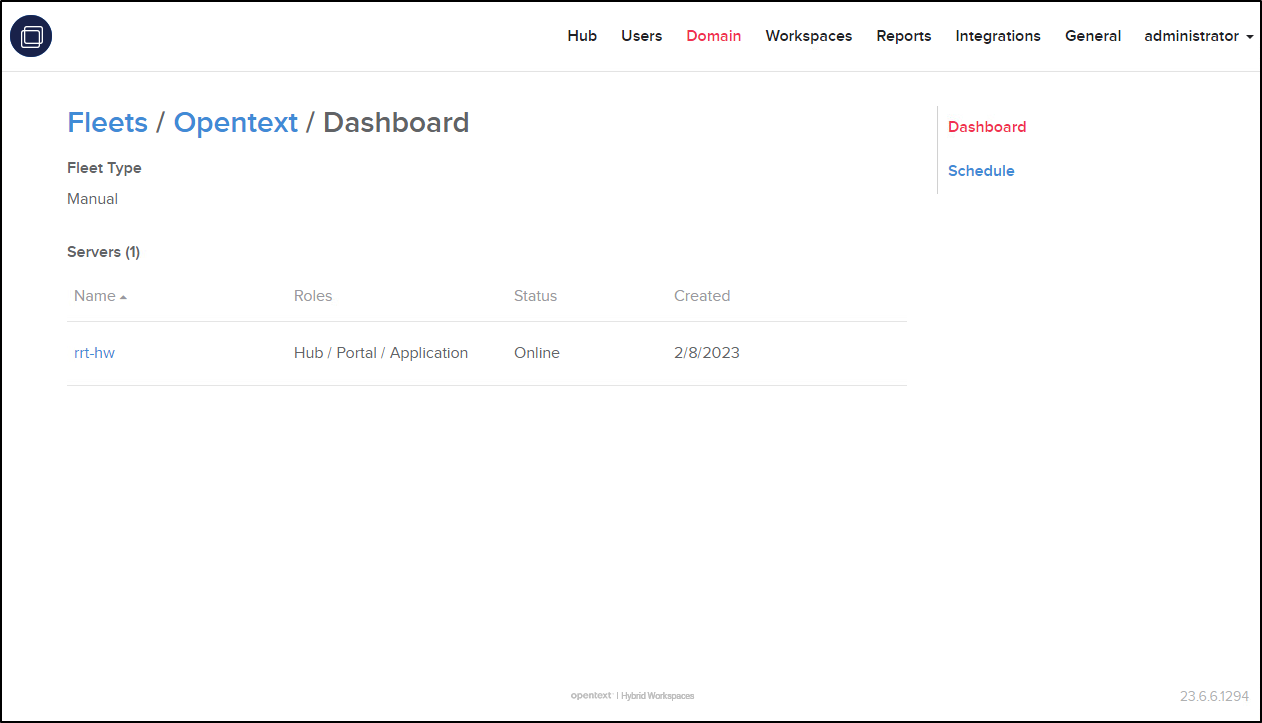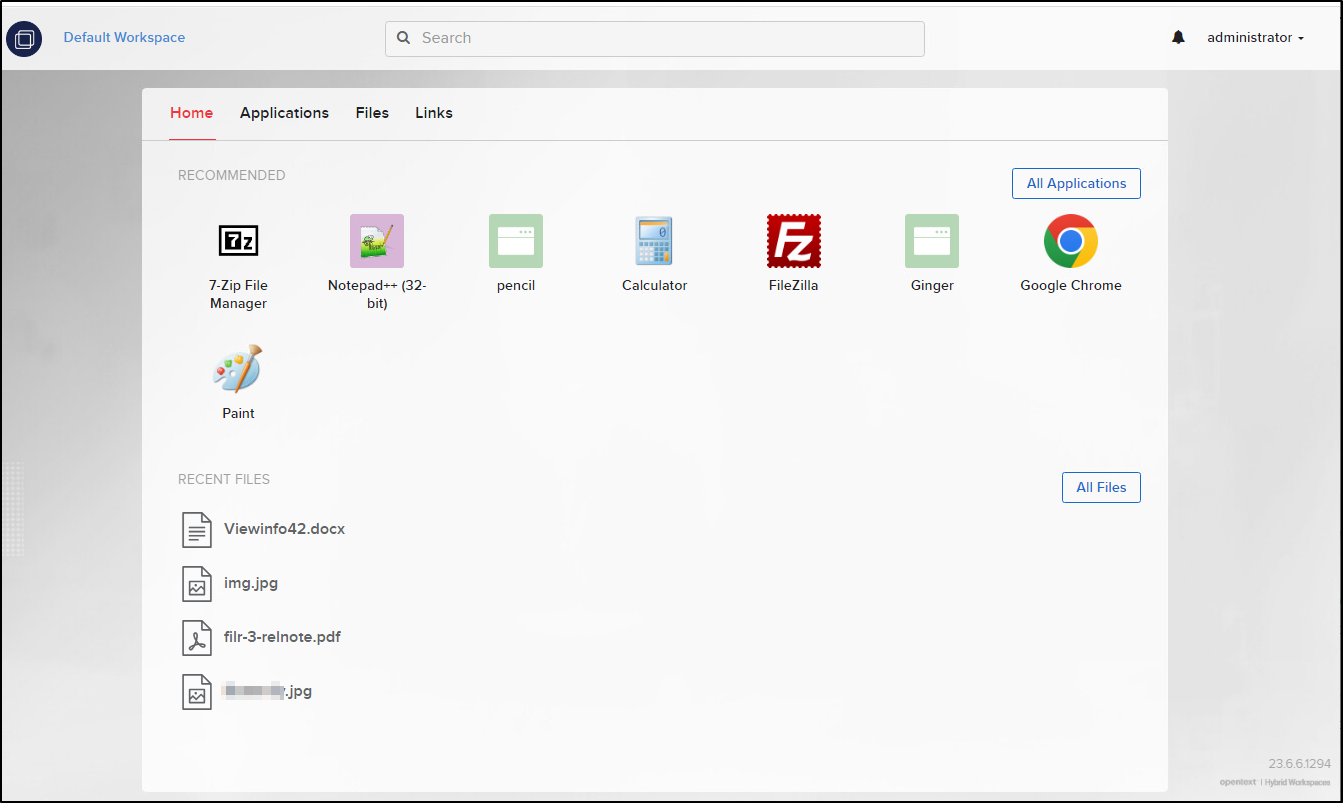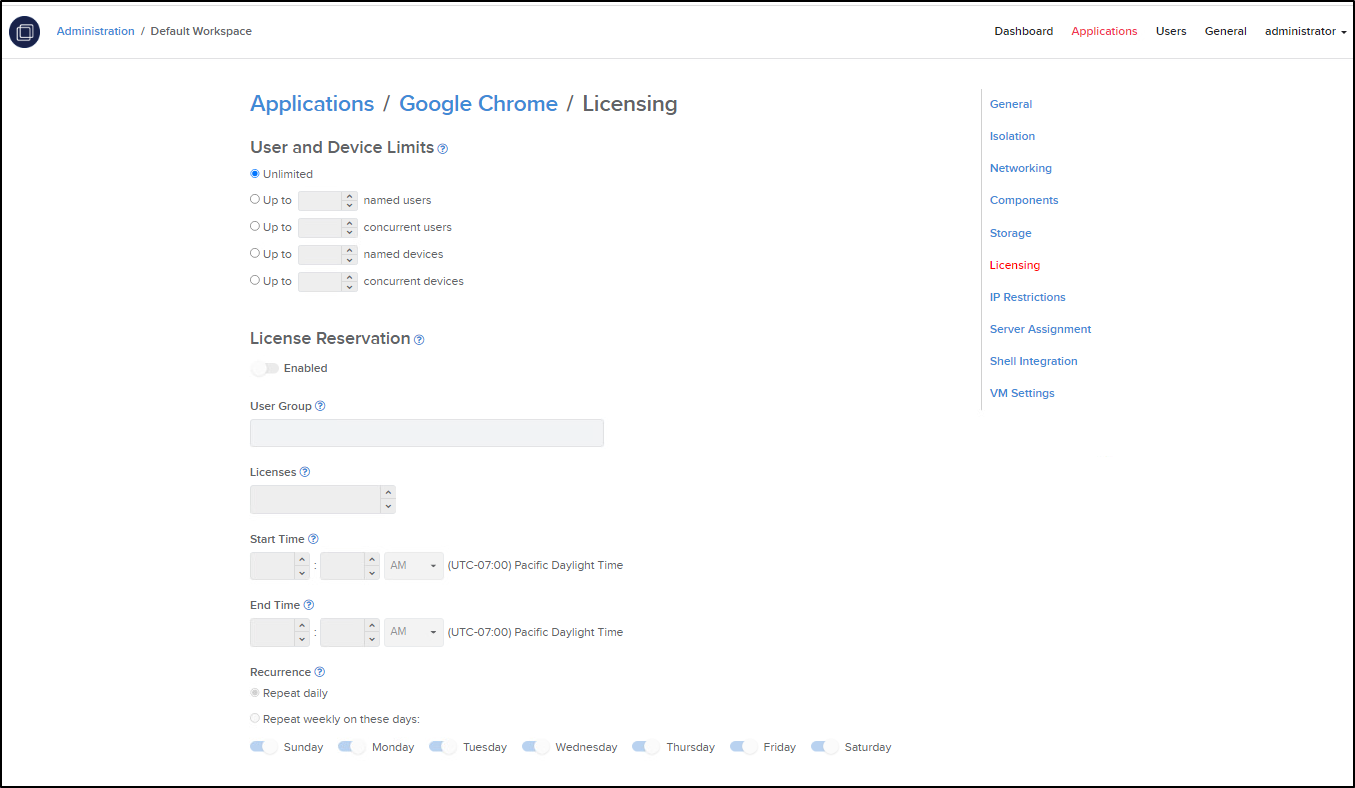Hybrid Workspaces 23.6 Readme
The information in this Readme pertains to Hybrid Workspaces Application Streaming and Packaging. Customizing applications to a virtual package and then delivering through application streaming on any platform with an HTML5 browser or even locally on a Windows OS device.
The following information is included in this Readme:
1.0 What’s New in Version 23.6
Hybrid Workspaces 23.6 includes the following updates:
Important note on the name change: Effective October 2022, the application's name is changed from Micro Focus Desktop Containers to Hybrid Workspaces.
1.1 Hybrid Workspaces - Application Streaming Server
This release includes several major features:
-
New! Fleets streamlines resource management by organizing groups of servers into a single management unit. Create on-premises fleets or use managed fleets that directly integrate with cloud infrastructures like Azure. Assign applications to fleets based on resource requirements.

-
New! Portal Dashboard design has been refreshed with a new Home tab that summarizes key applications and documents as well as new visuals.

-
New! (Beta) AI Chat feature allows end-users to talk with AI chatbots such as OpenAI's GPT-3.5 and GPT-4 directly within the workspace interface.
-
New! License Reservations feature allows licenses to be reserved for specific user groups during a configurable time period.

-
New! Web Applications are now a first-class application type that appear alongside other applications in the Portal. Web applications can open the client browser to an external site or launch within a virtualized browser environment. Web applications inherit the same management features as other application types.
-
Other new features include:
-
New! Initial Window State workspace application setting determines the initial window state when launching the application, such as full screen
-
New! Run as Administrator workspace application setting allows applications to launch the application with administrative privileges
-
New! VM Settings workspace and workspace application settings allow configuring advanced virtual machine runtime settings
-
Users now receive a warning notification if one of their storage provider connections fails to connect, which may result in a T: drive mount failure
-
-
Other improvements include:
-
Turbo Server has been upgraded to use .NET Framework 4.8. It is required to install .NET 4.8 before running the Turbo Server installer.
-
Server settings relating to storage have been moved to a new Storage tab
-
The Reboot Server button has been updated with a confirmation dialog and reboot status in the administration site diagnostics page
-
Session reports have been updated to report an error if the HTML5 client takes longer than expected to start
-
User Group Restrictions are now enforced on installed applications
-
The Hub Image Cache will now target the `images` subfolder, unless already specified, when referencing precached assemblies. This behavior is now consistent with the Turbo for PC client.
-
The Turbo Hub will now automatically populate the assembly cache and relevant metadata when an image is pushed to the Hub or when the image cache is updated.
-
Images will no longer be written to the image cache path if the image already exists
-
Improved performance of the Reports page for certain data sets
-
Improved Hub Server performance during periods of high launch volume
-
Improved service reliability when encountering SQL errors
-
Workspace application `merge-user` setting has been added to the administration CLI tool
-
Error messaging has been improved when providing an invalid license to the administration CLI tool
-
The Portal logs now use UTC time
-
The base and clean images have moved to `windows` namespace
-
-
This update includes fixes for the following issues:
-
Session reports did not accurately track session duration for HTML5 client sessions if the user closed the tab shortly after launch.
-
The Advanced Testing page could fail to override server assignments if the application was already running
-
Installed workspace applications with Inherit from Workspace isolation settings could fail to correctly inherit
-
In rare cases users could be automatically logged out of the Portal despite having a valid ticket
-
Channel selection could be lost when navigation to and from the Files tab
-
1.2 Hybrid Workspaces - Studio (Application Packaging Tool)
This update includes the following improvements and fixes:
-
The Turbo VM is updated to version 23.6.3
-
Fix unnecessary Turbo Image rebuild when publishing to Turbo Server
-
Fix Microsoft PowerBI error on startup when using DLL injection
-
Fix Microsoft Edge incompatibility when using DLL injection
-
Fix error when calling CopyFileExW and CopyFile2 with paths that contain forward slashes
-
Fix performance issues with NtQueryAttributesFile and NtQueryFullAttributesFile when using read-only virtual files
-
Fix unhandled exception when attempting to import a file that did not exist
-
Improve user interface elements
-
Add support for Activation Contexts which are activated with relative paths to application manifest
-
Add support for Windows RPC endpoint isolation with Named Object Isolation settings
-
Fix application manifest parsing which resulted in Microsoft Edge running in Windows 8 mode
-
Fix a potential crash on Windows 7 during container start
-
Fix for potential deadlock when calling the SuspendThread API
-
Fix unhandled exception when cancelling the login dialog
-
Fix MSI generation on Windows 11 and latest update of Windows 10
-
Improve Filesystem, Registry, and Desktop panels to show different folder icons if they are non-empty
-
Improve Capture process filter dialog to show more information about the processes
-
Add DisableFontPreload VM setting to improve launch speeds of containers with many fonts
-
Improve performance of heap allocations
-
Improve performance of write-copy registry operations
-
Improve handling of large log files in the Debugger
-
Allow Turbo for PC Client to pre-cache all executable files regardless of file extension
-
Fix for Chromium 112+ sandbox (affecting Chrome, Edge, PowerBI, etc)
-
Fix intermittent hang during application shutdown
-
Fix enumeration of Merge isolated registry keys that don't exist natively
-
Fix enumeration of OneDrive mapped profile directories
-
Fix hang when enabling diagnostics for applications that use synchronous named pipes
-
Fix application of legacy resource memory protection policy
-
Fix 64-bit Microsoft Office 2019+
-
Fix incorrect working directory when launching an existing container
-
Fix exception in Debugger Apply Configuration command when unable to install a service
-
Fix long filename error in Debugger Apply Configuration command
-
Fix for build error when manifest file container unexpected element namespaces
-
Fix for column resizing in Startup File dialog
-
Fix for error when loading configurations for standalone executables that don't have an output path assigned
-
Fix file removal can orphan associated startup files
-
Fix for using temp directory for large intermediate build files
-
Fix for not showing that an applied license is invalid
-
Fix for error when importing registry files that contain unknown value types
2.0 Known Issues
This section contains information about issues that might occur while you work with this release:
2.1 Do not upgrade to Hybrid Workspaces version 23.6 if using ZAM integration
The following ZAM integration error is displayed when you try to upgrade to Hybrid Workspaces version 23.6 if using ZAM integration:
System.Net.WebException: The remote server returned an error: (403) Forbidden. at System.Net.HttpWebRequest.GetResponse()
Do not upgrade to Hybrid Workspaces version 23.6 irrespective of the Hybrid Workspaces version you use.
3.0 Product Documentation
The following sources provide information about Hybrid Workspaces:
4.0 Understanding the Upgrade Requirements
-
All application configuration documents and application certificates created with ZENworks Application Virtualization 8.x, 9.x, 10.x, and 11.x must be re-created in order for application streams to work with the Hybrid Workspaces standalone components.
To generate a new certificate and regenerate the configuration files:
-
In the Advanced section of the Hybrid Workspaces Studio, click the App Config button to regenerate the application stream configuration files.
-
To generate a new site license certificate, click Advanced.
-
In the Application Certificates dialog box, click Request Certificate.
-
Specify the following information in the fields:
-
Organization: The organization name.
-
Unit: The user or unit name.
-
Allowed Portal Hosts: The allowed host names of the servers from which the application will stream.
-
-
Click Request to request the site license certificate, then save the certificate to a desired location.
-
Click the App Config button to regenerate the application stream configuration files again.
-
-
ZENworks Application Virtualization (ZAV) versions, Micro Focus Desktop Containers (MFDC) versions, and Hybrid Workspace versions always run side by side on a device. Running older versions (ZAV or MFDC) do not change in any way when running in a Hybrid Workspaces environment.
However, if you open a package built with ZAV or MFDC version of Studio, using the latest Hybrid Workspaces Studio, saving it automatically upgrades the package to the latest HW Studio Packager version and the older packaged version becomes obsolete and should be decommissioned.
5.0 Legal Notices
For information about legal notices, trademarks, disclaimers, warranties, export and other use restrictions, U.S. Government rights, patent policy, and FIPS compliance, see .
© Copyright 2008 - 2023 Open Text
The only warranties for products and services of Open Text and its affiliates and licensors (“Open Text”) are as may be set forth in the express warranty statements accompanying such products and services. Nothing herein should be construed as constituting an additional warranty. Open Text shall not be liable for technical or editorial errors or omissions contained herein. The information contained herein is subject to change without notice.